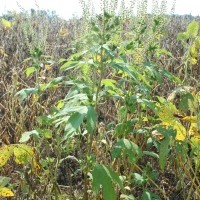Weed Worries Worsening

In fact, giant ragweed could be the weed to watch in 2007. By most accounts, the presence of giant ragweed in crop fields can lead to yield losses of 45% to 70% in soybeans and 10% in corn, primarily because of its ability to grow up to 1 inch per day during its peak growth stage.
“Giant ragweed has a number of characteristics that make it a ‘great’ weed, and inherently difficult to control,” says Mark Loux, professor and Extension specialist for the Department of Horticulture and Crop Science at The Ohio State University. “It emerges from late March through early July in Ohio, and management programs need to address this long period of emergence,”
Since giant ragweed is usually present in fields at planting, it should be controlled using a combination of preemergence and postemergence herbicides. In soybeans, this should include a preplant burndown herbicide treatment using 2,4-D ester plus either glyphosate or paraquat. Next, in fields with a history of giant ragweed control problems, post applications should utilize either glyphosate, fomesafen, lactofen, or cloransulam-methyl. In fields with a history of general weed control problems, this should be followed up by a second post application of glyphosate approximately three weeks later. With corn, a similar multiple herbicide approach should be used.
Other Weeds To Watch
With more continuous corn being projected for 2007, researchers predict that tall waterhemp will become more of a problem. According to John Long, district agronomist for Mycogen Seeds, this weed also is developing a tendency to emerge later during the growing season.
To combat this, Long suggests retailers conduct a thorough scouting of fields to determine how severe a tall waterhemp outbreak there might be. Once this is established, applying a half rate of preemergence herbicide is advised.






